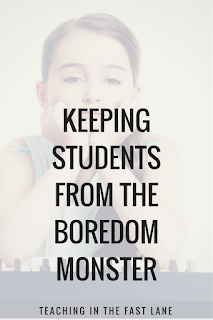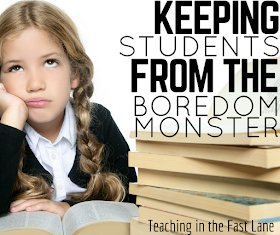This post contains Amazon affiliate links. If you click on the link and make a purchase I will receive a small commission, but you will not be charged any extra.
The truth is we can't. What we can do though is to create an engaging environment that is different from the other environments our students see daily. In this post I will describe six ways that you can achieve this. I promise that once you start, it will become a fun challenge to see how you can engage your students with each and every lesson.
Novelty
I am a lover of routine. I thrive on it, and our students do too. I am most definitely NOT telling you to throw routine out the window and start from scratch. What I would suggest is to mix it up a little inside of your routine.
This might look like changing out your stations with math challenges for a day, trying a new cooperative learning structure form the ones that you rely on, or completing your independent reading outside on a beautiful day.
The goal here is to keep the learning environment steady while enriching the experience to make it memorable in our students' eyes.
Playing to Students' Interest
Another winning idea for holding our students' attention is to play to their interests.
Have you noticed that your students are really into Pokemon Go? Turn it into a lesson on measurement!
Find a lizard that loses its tail when you try to get it back outside? Sounds like a great anticipatory set for learning about adaptations!
The goad here is to find out what your students are passionate about and bring it into their world. A couple of years back Minecraft was on the mind of every one of my students, and it offers a world of options in the classroom. Embrace it instead of fighting it!
Have your students do the hard work for you on this one too. If they are interested in the topic, have them do the research and brainstorm ways that they can use it in the real world. When it is their idea they are that much more invested in it, which is exactly what we are looking for!
Engaging Topics
You are probably thinking this is exactly what you just said, but this one has a slightly different goal. Where playing to their interests uses topics they are already interested/obsessed with, the idea of engaging topics is bringing in new information or ideas that they know little to nothing about, but will capture their imaginations.
The easiest way I have found to do this is to basically rewind ten years. Think about what our students then were obsessed with and build from there. Your students now are likely to be just as fascinated.
Another way of going about this is to use topics that are of interest to you. When your students see that you are passionate about a topic, they will be too. I use auto racing as a topic for just about every subject. It is a great "built in" topic for me to hook my students.
There are a few topics that capture students no matter what year. You probably already know them. My list would include dinosaurs, sharks, and cartoons, but there are many more!

Be Personal
So you are already using engaging topics, mixing it up within your routine, and choosing topics of interest to your students, so what is the next step? I would say to make learning more personal to your students.
It is standard for us to think about how we use the knowledge we gain in school in the real world, but how often do we share this with our students. By allowing students to see exactly how what they are learning will benefit them in the future they are instantly more engaged.
No one wants to think that they are being forced to do something that will have no benefits for them in life. Our students, no matter the age, understand this, and want the rationale behind the learning. Why don't we give it to them?
This is a GREAT reason for including project based learning or culminating projects that allow students to take ownership of their learning.
Use Humor
Humor is a great way of bridging a gap with disengaged students. I warn you though, don't EVER use humor, especially sarcasm, with the student as the target. That is a slippery slope, and you are almost sure to lose not only that student, but others as well.
Instead, break out your best dad jokes, knock knock pleasers, and academic related sillies to have your students rolling on the floor, or at least rolling their eyes in unison. You know, you wouldn't want to deprive them of a shared experience.
I wrote a post all about using humor to build the classroom community over on Classroom Tested Resources that includes how to use humor and where to find jokes. Check it out!
Movement
Sitting at a desk all day is tough for adults, and impossible for our students. Education has made vast improvements to our students' environments with the addition of flexible seating, which I applaud, but there is always room to grow.
Some great items to provide students with movement while working include wobble chairs, standing desks, foot pedals, and yoga balls.
In my opinion, in addition, to giving our students options to move while working we need to be providing structured opportunities for our students to get up and move through brain breaks, silly games, and learning activities.
One way for students to move through a shared experience is through these Science Dice Simulations that allow students to move around the room while reinforcing a science concept, then cap it off with a narrative writing project that is sure to knock your socks off!
If you are not already using GoNoodle then I would definitely check it out for brain breaks. Another source of endless fun and movement is this book, Silly Sports and Goofy Games, that can be easily integrated into content for an extra umph!
Do you want more tips like these sent directly to your inbox? Sign up for the Teaching in the Fast Lane Newsletter here.
Do you want more tips like these sent directly to your inbox? Sign up for the Teaching in the Fast Lane Newsletter here.


No comments:
Post a Comment